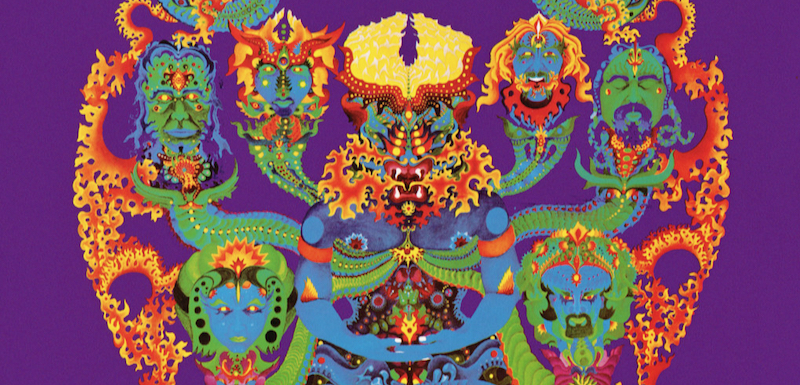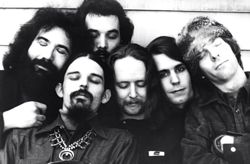
In the fall of 1967, the Grateful Dead had a problem.
One of the original big-buzz bands of the San Francisco scene, the Dead fell flat earlier in the year with their highly anticipated debut album. It was a thin and tinny collection dominated by blues and folk covers. The album’s cover art was psychedelic all right, but nothing else on the album qualified.
“The next one certainly won’t be like that in any way,” Garcia assured local radio listeners.
The heat was on. The Bay Area already had produced a pair of heady psychedelic masterpieces: the Jefferson Airplane’s “Surrealistic Pillow” and Country Joe and the Fish’s “Electric Music for the Mind and Body.” The Dead, however, seemed on course for mere local-legend status.
Determined to capture the essence of their psychedelic concerts the band returned to the studio with David Hassinger, who had produced their first album. Hassinger quit about a third of the way though the “Anthem” project. “They didn’t know what the hell they were looking for,” the star producer grumbled. Hassinger and the Dead’s label, Warner Bros., thought the band was “just jerking off” in the studio.
But by subbing in band soundman Dan Healy as a producer, the Dead found what they wanted — or needed.
Instead of making a straight-ahead album, they decided to mix studio and live recordings into a sonic “collage” that would sprawl across both sides of the album. The heavy lifting in post-production was done by guitarist Jerry Garcia and bassist Phil Lesh. “Phil and I performed the mix as if it were an electronic music composition,” Garcia recalled decades later.
No one would question the band’s psychedelic credentials after “Anthem”: “We mixed it for the hallucinations,” Garcia would say. The Hindi-inspired album cover art, done by band pal Bill Walker, became famous in its own right.
This second Grateful Dead album came more than a year after the first. Rolling Stone’s reviewer delivered a quick backhanded compliment: “Anthem” was “remarkably successful, especially when compared to the first Dead album.” (Rolling Stone eventually would place “Anthem” in the middle of its list of the greatest 500 rock albums.)
Back when people read album covers, “Anthem” offered a bit of a maze. “That’s It for the Other One,” the opening number, sprawled across four sections: “Cryptical Envelopment,” “Quadlibet for Tenderfeet,” “The Faster We Go, the Rounder We Get” and “We Leave the Castle.”
In part 1 of the song cycle Garcia plays lilting guitar and sings of a man “who has to die” — the guitarist later said the lyric was his roundabout interpretation of Calvary.
It’s a deceptively straightforward opening to a major slab of psychedelia. “The Other One’s” weirdness gets going at about 1:30, in the “Quadlibet” section, when the band’s twin drummers lead the band into a brief but heavy jam. (The album was percussionist Mickey Hart’s debut with the Dead.)
In “The Faster We Go,” Bob Weir speed-sings his way through the story of a “Spanish lady” whose rose “left a smoking crater of my mind.” And then the famous infectious chorus, some sweet relief that keeps “The Other One” suite from collapsing upon itself: “Comin’, comin’, comin’ around, comin’ around, comin’ around …” It’s the chorus that inspired a million patchouli-fueled attempts at Sufi whirling.
In the second part of the song, Weir eulogizes Beat Generation idol Neal Cassady, whose exploits included driving the Merry Pranksters’ psychedelic school bus. Weir sings:
The bus came by and I got on
That’s when it all began
There was cowboy Neal
At the wheel
Of a bus to never-ever land
Further fierce jamming leads into the darkly surreal instrumental section “We Leave the Castle,” created by band friend Tom Constanten, a practitioner of electronic music and a miner of “found sounds.” “Castle” is a masterpiece of futuristic squeaks and squawks; cinematic and heavy on apocalyptic overtones. (Constanten would soon join the band.)
The album’s second song, “New Potato Caboose,” is a prototypical Dead jam, establishing a template the band would use throughout its existence. “Caboose” extends the psychedelic soundscape of “The Other One” while proving far more listener friendly. Even so, “Caboose” makes plenty of twists and turns, and ignores the usual verse-and-chorus song structure. Garcia called the song “utterly odd.”
The opening studio section of the song employs harpsichord, celesta, piano, organ and chimes. The lengthy second half was recorded live. Garcia solos at length, but with precision. The double drummers and Ron “Pigpen” McKernan’s insistent organ keep this one solidly in the rock arena.
“Caboose” was written by bassist Phil Lesh and the poet Robert Petersen, whose lyrics continue the dark naturalistic imagery used in “The Other One” suite:
Sun comes up blood red;
Wind yells among the stone.
All graceful instruments are known.
Garcia said in the documentary “Anthem to Beauty” that he and Lesh mixed each side of “Anthem” as a piece, rather than song-by-song. “The Other One” (7:40) and “New Potato Caboose” (8:26) take up almost all of Side 1, except for Weir’s awkward rocker “Born Cross-Eyed.” Side 2 presents only two songs, adding up to about 21 minutes.
“Alligator” marks the first appearance of lyricist Robert Hunter, who shares credit with McKernan and Lesh.
The song starts off like an outtake from the first album, with kazoo and some zany-hippie singing. Three-plus minutes in, the drummers take over, the pulse quickens, and we’re off once again. The band wanders through a stretch of now-familiar uptempo jamming.
At the 9-minute mark, Garcia does some delightful riffing on Donovan’s “There Is a Mountain,” a minor radio hit of the day. (Guitar great Duane Allman, who sat in with the Dead, ran with the idea on the Allman Brothers’ “Mountain Jam” in 1972. But you heard it here first.)
“Caution (Do Not Stop on the Tracks)” dates back to the group’s Warlocks days. McKernan does some moderately successful white-guy funk ranting as the drummers keep the railroad theme going.
Feedback, used sparingly on “Anthem” to this point, becomes a major player in the song’s final third, with Garcia summoning electronic beasts and demons from his amp. On the 1993 CD rerelease, the feedback would get its own bonus track, following outstanding live versions of “Alligator” and “Caution.”
The album’s songs, all originals, would live on in the Dead’s repertoire, especially “The Other One” and “New Potato Caboose.” With their third album, “Aoxomoxoa,” (1969) the band began its journey away from the ambiguities of hardcore psychedelic music and toward their great roots-music works “Workingman’s Dead” and “American Beauty.”
Liner notes: A remixed (HDCD) version of “Anthem of the Sun” was issued in 2001 as part of Warner/Rhino’s “The Golden Road” box set. … Jerry Garcia said the album’s infamous sonic murk was a result of the band knowing little about mixing music for transfer to vinyl. … Garcia worked closely with the Airplane on “Surrealistic Pillow.” He was credited as “Musical and Spiritual Adviser.” … Warner Bros. released Weir’s “Born Cross-Eyed” as a single, probably because it was the only short song on the album. … Original pressings of “Anthem” had “The faster we go, the rounder we get” etched into the vinyl near the circular label.
More Grateful Dead content from Psychedelic Sight:

“You do not merely want to be considered just the best of the best. You want to be considered the only ones who do what you do.” Garcia was a genius — and there really isn’t anybody else like the Dead. Great post keep up the hard work.
Still my favorite Dead LP hands down. I was around when it came out and remember the disappointment with the 1st album, although I loved side 2, and couldn’t quite get why the press bashed it. I mean, the songs were great really but maybe expectations weren’t met, who knows! But Anthem, whew, it absolutely blew me away and still does.
I just picked up the newly reissued original 1968 mix (on 180g vinyl) of Anthem of the Sun. Although it tends to be a bit muddier at points than the more familiar 1972 remix, I find it to be somehow more psychedelic. My thanks to everyone involved on making this record available for the first time in over 40 years.
Their first studio masterpiece, after the weak debut. And my favorite Grateful Dead studio output along with the magnificent “Aoxomoxoa” (get the original mix, the real dead to me..) and that ol’ dusty gem of “Workingman’s Dead.” But the stage was their natural environment, where they let loose and gave their best, so I’d pick up “Live-Dead” and “Dick’s Picks Vol. 16” for the greatest of the trips. Salute.
Excellent review of an important masterpiece. (I did actually enjoy the 1st LP though; it was one of the first albums I purchased and blasted on my cheap little turntable in the basement.)
And we hallucinated to it often! Sadly now, I hear it more at funerals
That album cover was for the hallucinations too.
I love the story about Bob Weir asking for “thick air”, being field recordings of ambient noise from the city and from the desert which drove Dave Hassinger mad. I hope I’m not alone in thinking it wasn’t actually that much of a bizarre request.